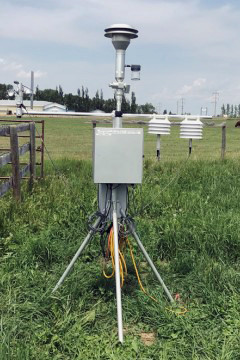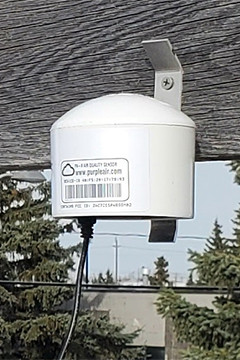Non-urgent government operations are closed December 24 to January 1, reopening January 2. View available services during this period.
Air quality monitoring
Alberta’s ambient air quality monitoring network is delivered through a distributed system, which includes industry, airsheds and the provincial and federal governments.
During episodes of poor air quality, such as wildfire smoke events, access to air quality information is important for Albertans to make informed decisions about their outdoor activities to protect their health.
Wildfire smoke can cause poor air quality and reduce visibility across the province. One of the major components of wildfire smoke with a risk to human health is fine particulate matter (PM2.5). PM2.5 is made up of very small particles, with a diameter of 2.5 micrometres or smaller. PM2.5 can be inhaled into the lungs and may cause health concerns.
Current air quality conditions
Air Quality Health Index
The Air Quality Health Index (AQHI) is a tool that relates outdoor air quality to your health, using a scale from 1 to 10. The lower the number, the lower the risk.

There are over 40 communities reporting the AQHI in Alberta. These are stations that monitor the 3 main AQHI pollutants:
- Fine particulate matter (PM2.5)
- Nitrogen dioxide (NO2)
- Ozone (O3)
AQHI monitoring stations may also measure other pollutants and meteorological parameters. Additional pollutants considered in Alberta’s AQHI calculations include:
- carbon monoxide (CO)
- hydrogen sulphide (H2S)
- sulphur dioxide (SO2)
- total reduced sulphur (TRS)
Get real-time air quality data with the AQHI map
For more about the AQHI, see: Air Quality Health Index
Other data on current conditions
In anticipation of and in response to wildfire activity, we deploy portable air quality monitors and works with partners to fill gaps using air quality sensors in areas not covered by traditional air monitoring stations.
-
 Environmental Beta Attenuation Mass data
Environmental Beta Attenuation Mass dataEnvironmental Beta Attenuation Mass (E-BAM) monitors measure particulate matter (PM10 or PM2.5). E-BAM monitors are relatively quick and easy to deploy.
- Met-One E-BAM Air Quality Monitor fact sheet
- AQHI map – As of the 2025 wildfire season, E-BAM data are available in near-real time on the AQHI map page under the 'Stations' or 'Query & Download' tabs.
-
 PurpleAir-II Sensor data
PurpleAir-II Sensor dataPurpleAir sensors only measure fine particulate matter (PM2.5). More than 120 PurpleAir sensors are currently deployed in Alberta, typically in cities and rural communities, to fill gaps in the provincial air monitoring grid. These sensors are owned by airsheds, citizen scientists, the Government of Alberta, the Government of Canada and other organizations.
Other air quality monitoring tools
Wildfire impacts resources
Access resources on health impacts of wildfires and actions that can be taken:
Alberta
- Alberta Health Services | Wildfire Resources
- Alberta’s Environmental Science Program | Air indicators – Wildfire smoke
- Hazard preparedness | Wildfire preparedness
- My Health Alberta | Wildfire smoke and your health
Other provincial
- BC Centre for Disease Control | Wildfire smoke